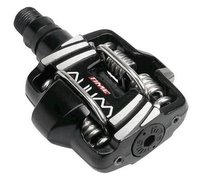Time Pedals
 After flopping around on MTB's for a couple of years I eventually got fed up with my feet slipping off the pedals and the loose pedal then impailing itself hard into my shin. A solution needed to be found and magazines/internet mentioned these damn fangled SPD (Shimano Pedal Dynamics) systems.
After flopping around on MTB's for a couple of years I eventually got fed up with my feet slipping off the pedals and the loose pedal then impailing itself hard into my shin. A solution needed to be found and magazines/internet mentioned these damn fangled SPD (Shimano Pedal Dynamics) systems.Upon further investigation it appears that the pedals and shoes have a mechanism that clamp the two together which are released again with a twist of the ankle. Now that might sound a little odd but yonks ago, I'd ridden road bikes (damn it, the secret's out!) when toe clips were common place. If you tightened 'em up they were quite frankly lethal, but at least you typically managed to stay upright on the smooth road surfaces where you also have plenty of forward vision for planning ahead. Off road is another story as the uneven ground is hazardous and you often don't have too long to plan a relaxed, calm dismount when you're whizzing along twisty singletrack.
After studying the options available it became clear that virtually all SPD shoes are compatible with all SPD pedals as the relevant cleat is simply bolted to the underside using a standard bolt pattern. It seems that some shoes can be awkward to use with some pedals, especially if they have deep, rugged soles.
As the hunt for shoes only required a good fit to the foot, I focused on hunting down information on which pedals were available and it pretty much boiled down to two choices;
- Shimano : Who had a miriad of pedal options from teeny race clips to big flat platforms, similar to those I'd been using but with the shoe retention system. Across the range they all seemed to have a tensioning system which means that whilst learning a low clamping force is applied for easy release. Once you're more familiar with dismounting with SPD's then you can increase the tension which also means that you'll be able to pedal with more conviction and not unclip unintentionally. The flip side to the tension adjust meant that cleat (the bit which fixes to the sole of your shoe) alignment was essentail as the mechanism doesn't provide much if any float and knee problems could result if poorly aligned. The Shimano pedals also had numerous moving parts with close tolerances which must work really well on the road but on muddy surfaces users reported that it was often difficult to clip back in once you'd walked around in the gloop.
- Time : Who had a limited choice of pedals and no tension adjusters, which kept the pedals looking neat and simple. Without any adjustment they instead opted for a double sided cleat with one side requiring a lesser 13 degrees ankle twist to unclip and the other a more retentive 17 degrees. Their design also allows a few degrees of float which apparently helped to save the knees from a poorly adjusted, rigid clamping mechanism. The simple nature of the design means that tolerances aren't as tight and that they are much more mud friendly when compared to Shimano.
Over the years they've proven to be very reliable with my original set now having covered well over 4k miles without the need for a service. The bearings are still sweet and much to my amazement I haven't even needed to change the cleats which is fantastic as they're now used every week day on my commuter. I've been so happy with them that I even acquired a second set which have shrugged off many a pedal on rock strike. They also work brilliantly off road and you can happily walk through muddy sections and then just stamp the pedals when re-mounting and you're clipped in. No fuss.
More recently, CrankBros have introduced a range of SPD pedals which uses a mechanism very similiar to Time with the exception that they are typically lighter and smaller. The cleats are also very similar and allow riders to swap rides without having to swap pedals. Shimano cleats aren't interchangeable with either of these systems but I believe they are with Shimano-esque versions from say the likes of Ritchey, etc.
There are other SPD's available, which I'm sure other riders are happy with but the Time ATAC Aliums have been a solid performer for me. I've no regrets and I'd happily recommend them to others.
Update: With Chipmunk now seeking to use SPD's and my happy time with Time's (ahem) we've opted for the platform pedal called the Time Z. It provides a larger area to plant your foot if you don't want to clip in and are also sufficiently comfortable to use without cleats/bike shows so are ideal for the 5 minute jaunt down to the pub wearing trainers. However, whilst learning we intend to use some cheapo Shimano pedals with the adjustable tension as I found that Time's (although excellent) do require a great deal of commitment and a fair amount of strength to use initially - until they bed in and you get familiar with the technique.

